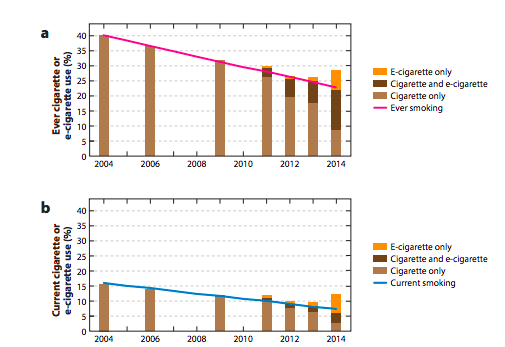
ABHISHEK ROY – MARCH 25, 2019
As I walk to my next class, I often notice a small plume of smoke rise above a stranger walking in front of me. It is not their breath because it is generally not that cold. If I were in India, I would have guessed it to be from a cigarette, but here in the U.S., I know from experience it is the vapor from a Juul. When I first came to Berkeley, I was surprised to find people carrying what seemed to me as USB flash drives in their hand. It was only after a sophomore student that I knew told me the truth behind the seemingly harmless, oblong devices I saw in every other person’s hand.
Juuls are an e-cigarette brand that, in the last three years, have seen a meteoric rise in popularity. As of June 2018, Juul controls 68% of the e-cigarette market, according to the global market research firm Nielsen Corporation. With just 1,500 employees, Juul Labs reported revenues of over $2 billion last year. They are valued at a massive $38 billion and received $12.8 billion for a 35% stake of the company from the tobacco giant Marlboro, making the investment one of the largest ever in a venture-backed start-up in the US. The company is generating a lot of cash and expanding the e-cigarette industry, but at what cost?
Despite investments by combustible cigarette companies to keep up with the times, the traditional cigarette industry has taken the brunt of the force from the new emerging market of e-cigarettes. The traditional cigarette market in the US grew by only 3% over the last five years to reach a value of $46 billion in revenues. Exacerbating the weak growth rate, there was a 2% decline in the number of businesses and a 3.3% decline in employment in this sector.
There are many factors that have dealt a blow to the traditional cigarette industry. The rise of health awareness, organic foods, nutritional fads, exercise, and the general shift to a healthier lifestyle has made many people quit smoking. At the same time, millions of people have found an alternate way to satisfy their daily nicotine addiction through e-cigarettes. As traditional cigarettes lose their appeal, companies like Juul and Suorin have provided the market with what are perceived as healthier alternatives.

The chart above depicts the increase in percentage of high school students who use e-cigarettes. This increasing trend is also shared by adults, although many adults also use tobacco products simultaneously. The charts below depict the increase in the use of e-cigarettes over normal cigarettes:

The main cause behind the shift from traditional to e-cigarettes has been people’s attitudes towards e-cigarettes and the difference in regulation between normal tobacco products and alternative electronic products. In the U.S., e-cigarettes are not subject to the same marketing laws and regulations as normal cigarettes. Consequently, companies like Juul spend huge sums on marketing (Juul has planned a $10 million marketing campaign for 2019) and have created a brand image. They portray themselves as less harmful than traditional combustible cigarettes because of the absence of carcinogenic elements. Moreover, the sleek design and the act of ‘Juuling’ has integrated itself into the lives of young adults. Using a Juul is cool, sociable and hip. The market size of e-cigarettes in the U.S. by revenue is about $3 billion and has a much higher growth rate than the traditional cigarette industry ever had.
Despite the industry’s growth rate, the huge rise of e-cigarettes has not dealt a huge blow to the cigarette industry. Old dedicated tobacco users will still resort to using traditional tobacco products. Additionally, e-cigarettes, which deliver a much higher nicotine dose, are proving to be a gateway for adolescents to start using traditional tobacco products. Furthermore, the e-cigarette market is projected to increase significantly around the world. With rising health consciousness and the social status lent by the usage of sleek electronic products, the cigarette and tobacco industry are making plans to adapt. Several leading U.S. tobacco and cigarette brands like Newport, Marlboro, and Camel are designing their own e-cigarettes to stay relevant.
However, this blooming industry is beginning to face several backlashes from humanitarian organizations and the FDA. The Juul delivers nicotine content comparable to an entire pack of cigarettes. The Suorin delivers an even higher amount. Although Juuling or vaping is not carcinogenic, it is highly addictive and in worst cases has led to addiction related issues among users. In November of last year, Juul narrowly dodged an FDA regulation banning them from selling flavours like mango, crème, and cucumber because of the popularity of these flavours among children. They agreed to suspend in-store sales of these flavours but will start selling them again if retailers impose age restrictions. In October of last year, Juul also faced a raid on their San Francisco headquarters. These incidents may just be the beginning of future setbacks for the Juul. The growth of the e-cigarette industry is based on the fact that this industry offers a healthier alternative to cigarettes. But is it truly ‘healthy’ or is it just less harmful than cigarettes? The answer to this question is not entirely clear. Given a few years, more detailed studies may be conducted, highlighting the harmful aspects of Juuls and other e-cigarettes as well, which will then allow the FDA and other government agencies to impose similar regulations on this industry as those on the normal cigarette industry.
Juul is reaping the benefits of e-cigarette market expansion. They have a healthy growth rate, a massive market share and billions of dollars in revenue. They have not significantly hurt the tobacco industry yet, but are forcing tobacco companies to change their strategies and develop new products in line with Juuls. However, the e-cigarette industry in the US is still small compared to the tobacco industry. Being able to harness the power of social media and marketing to boost sales right now does not necessarily mean they will prevail against the tobacco giants. With the amount of cash and influence in their hands, the tobacco and cigarette stalwarts have the capability to catch up with the trends. One thing is clear: neither of these industries will truly diminish in strength. By developing and selling better products, these businesses help satisfy addictions. Nicotine is a highly addictive substance, and, because of the nature of addiction, people keep using the substance in greater amounts. This addictive feedback loop is driven by nicotine users gradually requiring greater doses of the substance to experience the same effects. The traditional cigarette helps but in a dirtier way, with carcinogenic soot; the Juul is cleaner and sleeker but helps a person maintain the same nicotine addiction. The growth of the e-cigarette industry is a new generation but is it truly projecting a better world? Is it healthier to deliver greater concentrations of nicotine to get people hooked on e-cigarettes more easily? As long as man holds on to his vices, as long as the college student desperately needs his daily nicotine fix, these industries will always find a market.
Featured Image Source: Study Breaks
Disclaimer: The views published in this journal are those of the individual authors or speakers and do not necessarily reflect the position or policy of Berkeley Economic Review staff, the Undergraduate Economics Association, the UC Berkeley Economics Department and faculty, or the University of California, Berkeley in general.



